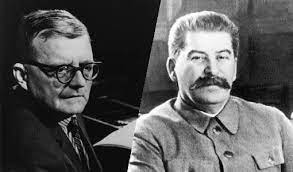 |
| Dmitri Shostakovich (1906-1975) and Josef Stalin (1878-1953) They were not friends. |
That year also marked the beginning of my serious study of Russian history, and so I was able to situate the life and work of the composer in the context of what was going on in the Soviet Union. Shostakovich enjoyed something of a love-hate relationship with the ruler of Soviet Russia. That was a perilous way to live in the Soviet Union of Stalin, and the ‘hate’ part came around after Stalin attended a performance of Shostakovich’s opera of 1936. Just as another murderous wave of purges was getting underway, Shostakovich, his opera, and his fourth symphony were denounced in every official publication.
Aware that not only his career but also his very life hung in the balance, the next year Shostakovich composed and published the fifth symphony, which was approachable enough for a teenager with little prior knowledge of music (like me!) to like it. The composer added the note that it was “A Soviet artist's creative response to just criticism.” He returned to good standing with the authorities, for a time.
The teetering brink between love and hate from the authorities would continue for the rest of his life, and that would leave a mark on the man and his music. But this one episode that I learned early on would introduce me to one of the characteristics of Soviet and Stalinist tyranny that extended far beyond the realm of music, art, and culture, to every aspect of daily life under that oppressive regime.
When Shostakovich went from rock star (so to speak) to pariah overnight, the accusation levied against him by the cultural commissars and music critics was one of “formalism”. This was a completely made-up word. It gave a patina of the thinnest sort to the accusations against him, which were simply rooted in the dictator’s dislike.
Ideological revolutionaries then and now have tipped their hands by resorting to this technique for hiding the murderous subjectivity behind declaring somebody or something an enemy because of the ideologue’s desire to eliminate the person, group, or phenomenon. Some cockamamie terminology is cooked up to make it seem that a grave crime has been committed, when all that really occurred was that an individual or group, previously favored, suddenly got sideways of the tyrant. The result is that there is only one possible fate for an “enemy of the revolution.”
“Formalism” was not then nor is it now much of a genuine musical thing, though the term has been used by a few music critics since Stalin’s time. But it reflects the power of attaching an “-ism” to any adjective and making it an accusation, and an easy technique for making any difference of opinion, or even style, into a status of dissent, and to confer the identity of enemy. Moreover, once you attach an “-ism” to a person, you make him an “-ist,” and thereby reduce him to less than his human reality.
Ideologues continue to wield these terms in our own time, eliminating the human standing of those to whom they are attached. “Homophobes,” “RINOs,” and “climate-deniers,” are all nonsense words that designate something that merits a social death sentence in the circles in which they are used. Ideological tyranny and tyrannical ideologues are not confined to the pages of history, far away lands, or even the secular sphere. Even in the Church, the appellation of newly-minted “-isms” and “-ists” reveals more about the person wielding them than it does about the people so labeled.
Truth, beauty, and goodness are real and present, but the hatred of them all is neither long ago, nor far away.
Monsignor Smith


